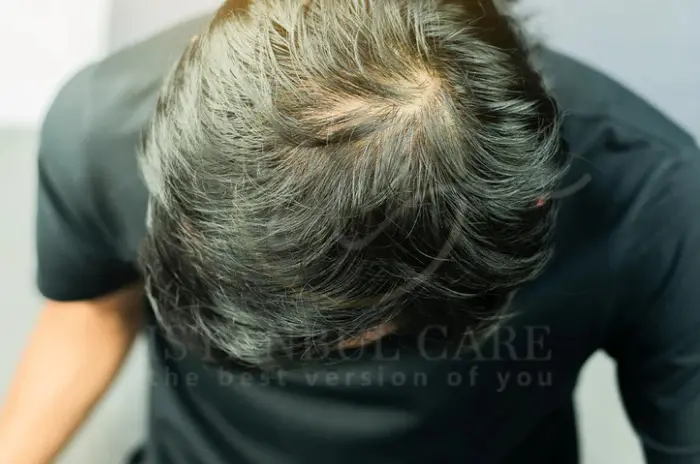Cowlick Hairlines are one of the most frustrating hair challenges that many people face daily. These stubborn sections of hair that grow in different directions can turn a good hair day into a styling nightmare. Understanding what causes cowlicks and learning effective management techniques can help you work with your natural hair patterns rather than against them.

What Is a Cowlick and Why Does It Happen
A cowlick is a section of hair that grows in a different direction from the surrounding hair, creating a natural whorl or spiral pattern. The term originates from the appearance of hair that looks as if it has been licked by a cow’s rough tongue, leaving it standing up or lying flat in an unusual direction.
Cowlicks are entirely genetic and form during fetal development when hair follicles are established. The direction of hair growth is determined by the angle at which hair follicles are embedded in the scalp, creating permanent growth patterns that remain consistent throughout life.
Common Cowlick Locations:
- Crown area: Most common location, creating circular patterns
- Hairline: Front hairline cowlicks affecting styling and parting
- Nape of neck: Lower hairline cowlicks influencing hair length decisions
- Temples: Side hairline areas that affect face-framing styles
Cowlick Formation Process:
| Development Stage | Timing | Characteristics |
|---|---|---|
| Fetal development | 10-20 weeks gestation | Hair follicle direction established |
| Birth | At birth | Cowlick patterns visible |
| Childhood | Throughout growth | Patterns become more defined |
| Adulthood | Lifelong | Permanent directional growth |
The strength and visibility of cowlicks can vary based on hair texture, density, and length. Fine hair often shows cowlicks more prominently, while thick, coarse hair may camouflage them better. Additionally, hair length plays a crucial role—very short cuts can make cowlicks more apparent, while longer hair may weigh down the area and reduce visibility.
Understanding that cowlicks are natural and genetic helps eliminate frustration and redirects focus toward working with them rather than trying to eliminate them completely.
How to Identify a Cowlick in Your Hair
Identifying cowlicks in your hair is the first step toward effective management. Many people struggle with styling challenges without realizing they have cowlicks that require specific techniques and approaches.
The easiest way to spot a cowlick is to examine your hair when it’s damp and combed in its natural direction. Look for areas where hair grows in circular patterns, stands up despite efforts to flatten it, or naturally parts in unexpected directions.
Cowlick Identification Checklist:
- Hair that won’t lie flat despite styling efforts
- Circular or spiral growth patterns visible when hair is wet
- Areas where hair naturally separates or creates unwanted parts
- Sections that stick up or grow in opposite directions
- Hair that appears thinner due to directional growth patterns
Common Cowlick Patterns:
| Pattern Type | Characteristics | Difficulty Level |
|---|---|---|
| Single cowlick | One directional change | Easy to manage |
| Double cowlick | Two adjacent patterns | Moderate difficulty |
| Multiple cowlicks | Several throughout scalp | Requires comprehensive strategy |
Single cowlicks create one directional change, typically appearing as circular whorls. Double cowlicks involve two adjacent growth patterns, often creating more complex styling challenges. Some individuals have multiple cowlicks throughout their scalp, requiring comprehensive styling strategies.
Men often have more noticeable cowlicks due to shorter hairstyles that don’t provide weight to control the hair direction. Women may have cowlicks that are less apparent due to longer hair length and different styling approaches, but they still require management techniques.
Professional Tips to Smooth Out a Stubborn Cowlick
Professional stylists have developed numerous techniques for managing stubborn cowlicks effectively. These methods focus on working with natural hair growth patterns rather than fighting against them, resulting in more successful and longer-lasting styles.
The most effective approach involves using heat tools to temporarily redirect hair growth. Start by applying heat protectant, then use a blow dryer with a round brush to guide hair in the desired direction while the hair is still damp.
Step-by-Step Professional Method:
- Apply heat protectant and volumizing mousse to damp hair
- Isolate the cowlick area for focused attention
- Use a round brush to direct hair opposite to its natural growth
- Apply medium heat while maintaining tension with the brush
- Allow hair to cool completely before releasing tension
- Apply light-hold hairspray to maintain the style

The Right Hair Products to Control Cowlicks
Selecting appropriate hair products is crucial for successful cowlick management. The right combination of products can provide control, hold, and flexibility while maintaining natural-looking results.
Heat protectants form the foundation of any cowlick management routine, protecting hair from thermal damage while providing a base for other products. Volumizing mousses add body and lift, helping to camouflage cowlick areas by creating overall volume.
Product Selection by Hair Type:
- Fine Hair: Light mousses, thermal sprays, flexible hold hairsprays
- Medium Hair: Volumizing creams, medium-hold gels, texturizing sprays
- Thick Hair: Strong-hold mousses, smoothing serums, firm-hold hairsprays
- Curly Hair: Curl-defining creams, anti-humidity products, lightweight oils
Product Application Order:
| Step | Product Type | Purpose |
|---|---|---|
| 1 | Heat protectant | Thermal protection |
| 2 | Volumizing mousse | Body and control |
| 3 | Styling cream | Smoothing and definition |
| 4 | Hairspray | Hold and setting |
Look for products containing polymers that provide flexible hold without stiffness. Avoid heavy oils or creams that can weigh down fine hair and make cowlicks more prominent.
How Hair Growth Patterns Affect Cowlicks
Understanding hair growth patterns provides insight into why cowlicks behave as they do and how to work with them effectively. Hair growth follows specific cycles and directions that influence cowlick appearance and manageability.
The anagen (growth), catagen (transition), and telogen (resting) phases affect cowlick visibility. During active growth phases, cowlicks may appear more prominent as new hair emerges in the established directional pattern.
Growth Direction Factors:
| Factor | Influence Level | Management Impact |
|---|---|---|
| Genetic programming | Primary | Determines basic pattern |
| Hair texture | Secondary | Affects visibility |
| Hair length | Variable | Changes appearance |
Longer hair provides natural weight that can help control cowlicks by pulling hair downward. However, excessive length without proper layering can create a bottom-heavy appearance that emphasizes cowlick areas.
Hairstyles that work well with cowlicks
Choosing hairstyles that complement rather than fight cowlicks can transform a styling challenge into a distinctive feature. The key is selecting cuts and styles that incorporate natural growth patterns into the overall design.
Men’s Cowlick-Friendly Styles:
- Textured crops: Embrace natural movement and direction
- Side parts: Work with natural cowlick placement for effortless styling
- Pompadours: Use crown cowlicks to create natural lift and volume
- Buzz cuts: Minimize cowlick appearance through uniform length
Women’s Cowlick-Accommodating Styles:
| Style Type | Cowlick Location | Benefits |
|---|---|---|
| Layered bob | Crown and nape | Creates movement |
| Side-swept bangs | Front hairline | Camouflages patterns |
| Pixie cut | Multiple areas | Embraces texture |
| Long layers | Crown area | Adds weight and flow |
The best cowlick-friendly hairstyles offer multiple styling options, allowing for different looks depending on the occasion. Versatile cuts accommodate both smooth, polished styles and tousled, textured appearances.
Common Mistakes That Make Cowlicks Worse
Many people inadvertently make their cowlicks more prominent through common styling mistakes and misconceptions. Avoiding these errors can significantly improve cowlick management and overall hair appearance.
Common Styling Mistakes:
- Fighting against natural growth patterns instead of working with them
- Using the wrong brush size or type for hair length and texture
- Applying heat tools at incorrect angles that emphasize cowlicks
- Cutting hair too short, which removes the weight needed to control cowlicks
- Ignoring professional advice and attempting complex styling without proper technique
Speak with our expert Hair Transplantation specialists

Speak with our expert Hair Transplantation specialists
We’re ready to answer your questions
Frequently Asked Questions
A cowlick is a section of hair that grows in a different direction from the surrounding hair, creating a natural whorl or spiral pattern. It’s caused by the genetic angle at which hair follicles are embedded in the scalp during fetal development. This growth pattern is established between 10-20 weeks of gestation and remains permanent throughout life. Cowlicks are entirely hereditary and cannot be permanently changed, only temporarily managed through styling techniques.
The most effective products for cowlick control include volumizing mousses for body and lift, heat protectants for thermal styling, and flexible-hold hairsprays for setting. Fine hair benefits from lightweight mousses and thermal sprays, while thick hair requires stronger-hold products like smoothing serums and firm-hold sprays. Apply products to damp hair, focusing on the cowlick area, and use heat styling tools to redirect hair growth temporarily.
Identify cowlicks by examining damp, naturally combed hair for circular or spiral growth patterns, areas that won’t lie flat despite styling efforts, and sections where hair naturally separates or parts unexpectedly. Look for hair that sticks up or grows in opposite directions from surrounding areas. Professional assessment provides the most accurate identification, especially for complex patterns or multiple cowlicks.
Yes, strategic haircuts can significantly improve cowlick management. Layered cuts create movement that disguises directional changes, while appropriate length provides weight to control stubborn areas. Side-swept bangs can camouflage front hairline cowlicks, and textured styles embrace natural patterns rather than fighting them. Professional consultation ensures optimal cut selection based on cowlick location, hair type, and personal style preferences.

